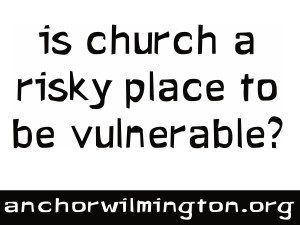So many times in modern culture we lack the skill to be vulnerable. Society makes it very easy for us to hide: we can photoshop our physical imperfections on social media and we post the edited version of our life on Facebook and Twitter. This same scenario is played out in church. We try to look our best with our Sunday clothes, our Sunday smile, and Sunday conversation. Some of us are completely unrecognizable Monday through Saturday!
The church has fueled this charade as well: the gilded image we so carefully construct hides the hurt, the pain, and the real struggles we may be facing. For most of us, church is a very risky place to be vulnerable. If we were to come clean about our shortcomings or trials, judgment and hushed whispers would follow; the embarrassment and chastisement would prove too much for us to show up the next week.
Here at The Anchor, we understand that everyone has a story, and sometimes that story is filled with a debris field. And that’s perfectly fine. The important thing is that you have someone that is willing to listen to your story – and that you are willing to share it. We believe that we are to be an eclectic group of people that are moved with compassion. Because of this eclectic nature – we do not fit into a cookie cutter mold – and we are all still works in progress.
Instead of merely showing up for a worship service, where one is showing their best self, we invite folks to come along side people and meet them where they’re at in life; “to rejoice with those who rejoice and to mourn with those who mourn” (Romans 12.15). It means taking care of the whole person, not just their spiritual needs. It is an invitation to practice restoration. No longer are we content with people just praying the “sinner’s prayer” and then going about their daily lives: we want real, authentic believers who reach out to others, to quite literally be the hands and feet of Jesus. There is no set standard – sometimes we move furniture and meet with refugees to help integrate them into United States culture and English language. Other times it is meeting someone for dinner to chat about life, buying linens for a family in need, baby showers for expecting moms, or simply inviting everyone over to someone’s house for a meal and interacting with each other.
The myriad of eclectics in the group means there is always a place for new faces. We understand that for many being vulnerable, especially in a church setting, is a very scary thing. By listening to each other and doing good together, we can embody hope–a hope that is real and tangible, a hope in which vulnerability is celebrated.
